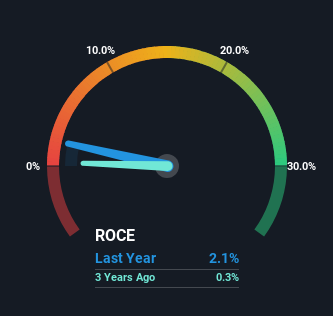- United States
- /
- Professional Services
- /
- NYSE:DNB
Dun & Bradstreet Holdings (NYSE:DNB) Could Be Struggling To Allocate Capital

If we want to find a potential multi-bagger, often there are underlying trends that can provide clues. Firstly, we'd want to identify a growing return on capital employed (ROCE) and then alongside that, an ever-increasing base of capital employed. If you see this, it typically means it's a company with a great business model and plenty of profitable reinvestment opportunities. However, after briefly looking over the numbers, we don't think Dun & Bradstreet Holdings (NYSE:DNB) has the makings of a multi-bagger going forward, but let's have a look at why that may be.
What Is Return On Capital Employed (ROCE)?
If you haven't worked with ROCE before, it measures the 'return' (pre-tax profit) a company generates from capital employed in its business. Analysts use this formula to calculate it for Dun & Bradstreet Holdings:
Return on Capital Employed = Earnings Before Interest and Tax (EBIT) ÷ (Total Assets - Current Liabilities)
0.021 = US$175m ÷ (US$9.1b - US$937m) (Based on the trailing twelve months to September 2023).
So, Dun & Bradstreet Holdings has an ROCE of 2.1%. Ultimately, that's a low return and it under-performs the Professional Services industry average of 12%.
Check out our latest analysis for Dun & Bradstreet Holdings

Above you can see how the current ROCE for Dun & Bradstreet Holdings compares to its prior returns on capital, but there's only so much you can tell from the past. If you'd like, you can check out the forecasts from the analysts covering Dun & Bradstreet Holdings here for free.
What Does the ROCE Trend For Dun & Bradstreet Holdings Tell Us?
When we looked at the ROCE trend at Dun & Bradstreet Holdings, we didn't gain much confidence. Over the last five years, returns on capital have decreased to 2.1% from 43% five years ago. Meanwhile, the business is utilizing more capital but this hasn't moved the needle much in terms of sales in the past 12 months, so this could reflect longer term investments. It's worth keeping an eye on the company's earnings from here on to see if these investments do end up contributing to the bottom line.
On a side note, Dun & Bradstreet Holdings has done well to pay down its current liabilities to 10% of total assets. That could partly explain why the ROCE has dropped. What's more, this can reduce some aspects of risk to the business because now the company's suppliers or short-term creditors are funding less of its operations. Since the business is basically funding more of its operations with it's own money, you could argue this has made the business less efficient at generating ROCE.
What We Can Learn From Dun & Bradstreet Holdings' ROCE
In summary, Dun & Bradstreet Holdings is reinvesting funds back into the business for growth but unfortunately it looks like sales haven't increased much just yet. Since the stock has declined 52% over the last three years, investors may not be too optimistic on this trend improving either. In any case, the stock doesn't have these traits of a multi-bagger discussed above, so if that's what you're looking for, we think you'd have more luck elsewhere.
On a final note, we found 2 warning signs for Dun & Bradstreet Holdings (1 is potentially serious) you should be aware of.
While Dun & Bradstreet Holdings isn't earning the highest return, check out this free list of companies that are earning high returns on equity with solid balance sheets.
New: Manage All Your Stock Portfolios in One Place
We've created the ultimate portfolio companion for stock investors, and it's free.
• Connect an unlimited number of Portfolios and see your total in one currency
• Be alerted to new Warning Signs or Risks via email or mobile
• Track the Fair Value of your stocks
Have feedback on this article? Concerned about the content? Get in touch with us directly. Alternatively, email editorial-team (at) simplywallst.com.
This article by Simply Wall St is general in nature. We provide commentary based on historical data and analyst forecasts only using an unbiased methodology and our articles are not intended to be financial advice. It does not constitute a recommendation to buy or sell any stock, and does not take account of your objectives, or your financial situation. We aim to bring you long-term focused analysis driven by fundamental data. Note that our analysis may not factor in the latest price-sensitive company announcements or qualitative material. Simply Wall St has no position in any stocks mentioned.
About NYSE:DNB
Dun & Bradstreet Holdings
Provides business to business data and analytics in North America and internationally.
Good value with moderate growth potential.
Similar Companies
Market Insights
Community Narratives



